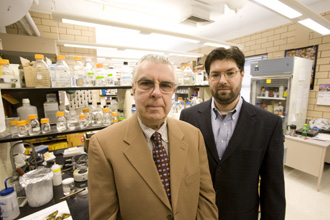 Target the Toxin
Target the Toxin
David Lenz '61 leads an effort to create a nerve-agent antidote, with help from Thomas Magliery '96
On March 20, 1995, Japanese terrorists released liquid sarin on five Tokyo subway trains during the morning rush hour. A highly toxic chemical, sarin affects the central nervous system, leading to loss of muscle control and disruption of the respiratory system. A single drop the size of a head of a pin can be fatal. On that Monday morning in Japan, twelve people died and more than 5,500 had to seek medical attention.Nerve agents such as sarin are relatively inexpensive and easy to produce, making them an ideal weapon for chemical warfare. Unless the exposure is massive--which usually causes death in minutes--the effects of sarin gas are treatable. But what if they were also preventable?
That's the aim of a new study led by David Lenz '61, a research scientist with the U.S. Army Medical Research Institute of Chemical Defense at the Aberdeen Proving Ground in Maryland. The effort, funded by a five-year, $14.4-million grant from the National Institutes of Health, seeks to develop an antidote for nerve agents such as sarin that could be given in advance of a chemical terrorist attack.
Lenz and colleagues at five research centers around the world are developing bioscavengers--protein molecules injected into the bloodstream to protect against chemical nerve agents. Lenz's group has already developed one bioscavenger drug, butyryl-cholinesterase, which will soon enter Phase 1 clinical trials.
But this drug only binds the toxins in the bloodstream. Lenz's goal is to create "catalytic" bioscavengers. He explains: "Rather than binding material, catalytic bioscavengers would actually destroy the toxin."
Three of the research teams are working to enhance the activity of human proteins that scientists have already identified as potential bioscavenger candidates. The other two teams will figure out the best organic system in which to produce the proteins in massive quantities. Once this feat is accomplished, the samples will be sent to Lenz's lab in Maryland, one of the few facilities approved to work with chemical nerve agents.
A partner in the effort is another Kenyon graduate, Thomas Magliery '96, an assistant professor of chemistry and biochemistry at Ohio State University (OSU). Magliery works with two research teams at OSU on this project and will be involved both in the study of the proteins' chemical properties and in the production of a bioengineered protein to be used in the antidote.
In most drug development scenarios, scientists use bacteria or yeast to grow the desired molecules. In this case, however, bacteria don't work well. So Magliery's group plans to use algae, which is easy to grow and cheap to produce.
"Proteins produced in plants don't tend to carry contaminants that cause immune reactions the same way that proteins produced in bacteria do," Magliery says.
Though their study is in the early stages, preliminary results suggest the scientists are on the right track. Still, it will be years before they know for certain, and longer still before their work will result in a drug. The government most likely would partner with a pharmaceutical company to produce the drug, which will be intended for civilian use. The question of when to distribute the antidote, and to whom, has yet to be decided.
Do you have feedback on this page?
